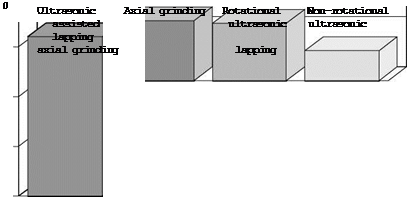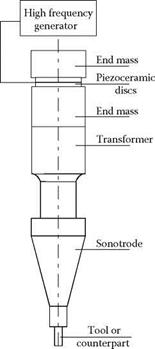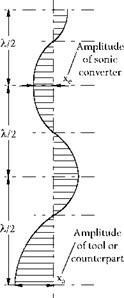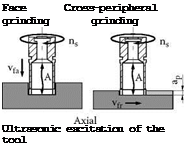Elastomechanical ultrasonic vibration is generated by the transformation of electric energy in piezoceramic or magnetostrictive sonic converters. A voltage generator converts a low-frequency mains voltage into a high-frequency alternating-current voltage. The generated longitudinal vibrations are periodic elastic deformations of the mechanical vibration system in the micrometer range at supersonic frequencies, that is, higher than f = 16 kHz. The sound-generating unit preceding the actual ultrasonic tool or shape-generating counterpart consists of a sonic converter, an amplitude transformer (transforming sections), and sonotrodes [Spur and Holl 1995]. Figure 20.2 shows the design of a vibration system.
 |
FIGURE 20.1 Achievable material removal rates during the machining of aluminum oxide depending on the applied manufacturing method. (From Cartsburg 1993. With permission.)
 |
 |
Mechanical longitudinal oscillation Design of vibration system
The process of sound generation and transformation should be largely free of losses in order to obtain a high total efficiency of the vibration system. At the same time, it is required to produce maximum vibration amplitude at the sonic converter to reach sufficient amplitude at the effective surface for the machining task. A mainly loss-free increase in amplitude is guaranteed by means of resonance, that is, a vibration with a frequency that corresponds to that of the eigenfrequency of the system. This requires that the geometrical lengths of the single elements must correspond to half the wavelength of the vibration or an integral multiple.
The amplitude of the converter, however, is generally too low for machining. It can be raised to a value sufficient for machining by a subsequent transformer. The sonotrode serves as a tool holder as well as an adaptation to the resonance of the entire vibration system. In addition, there is the possibility to design the sonotrode in a way that allows extra amplitude to be achieved [Haas 1991]. The ultrasonic vibration unit is clamped at the points where vibration nodes occur, because acceleration and amplitude are zero at these points and, thus, normal force freedom predominates.
Electric energy is converted into mechanical vibrations in modern machinery using the piezoelectric effect. It is related to the reversible property of special ceramic materials to deliver electric voltage when affected by external forces. This property is used for the generation of ultrasonic vibration by converting applied voltage into mechanical vibrations. Modern sonic converters usually contain several piezoceramic discs of lead zirconate titanate restricted by two final masses that are mechanically prestressed by a center screwing.
In the course of grinding, ultrasonic frequency can be introduced into the contact zone by the tool as well as by the workpiece. An excitation of oscillation of the workpiece takes place when the dimensions and the weight of the tool do not allow a high-frequency introduction of oscillations with low amplitudes. Depending on the position of the active partners relative to each other and on the direction of oscillations, there are different process modifications that allow the realization of machining tasks (Figure 20.3).
It has been proved that process improvement through ultrasonic superposition can be achieved, particularly where grinding is characterized by constant workpiece-wheel contact. These contact conditions particularly apply to face and cross-peripheral grinding. Moreover, investigations on peripheral grinding showed that the effects resulting from ultrasonic assistance have a more pronounced effect on the work result with increasing contact length [Spur and Holl 1995]. Thus, contrary to creep-feed grinding, hardly any process improvement could be observed in the case of reciprocating grinding.
 |
 |
Process variants of ultrasonic assisted grinding
Ultrasonic excitation of the workpiece
FIGURE 20.3 Process modifications of ultrasonic assisted grinding. (From Uhlmann and Holl 1998a. With permission.)
